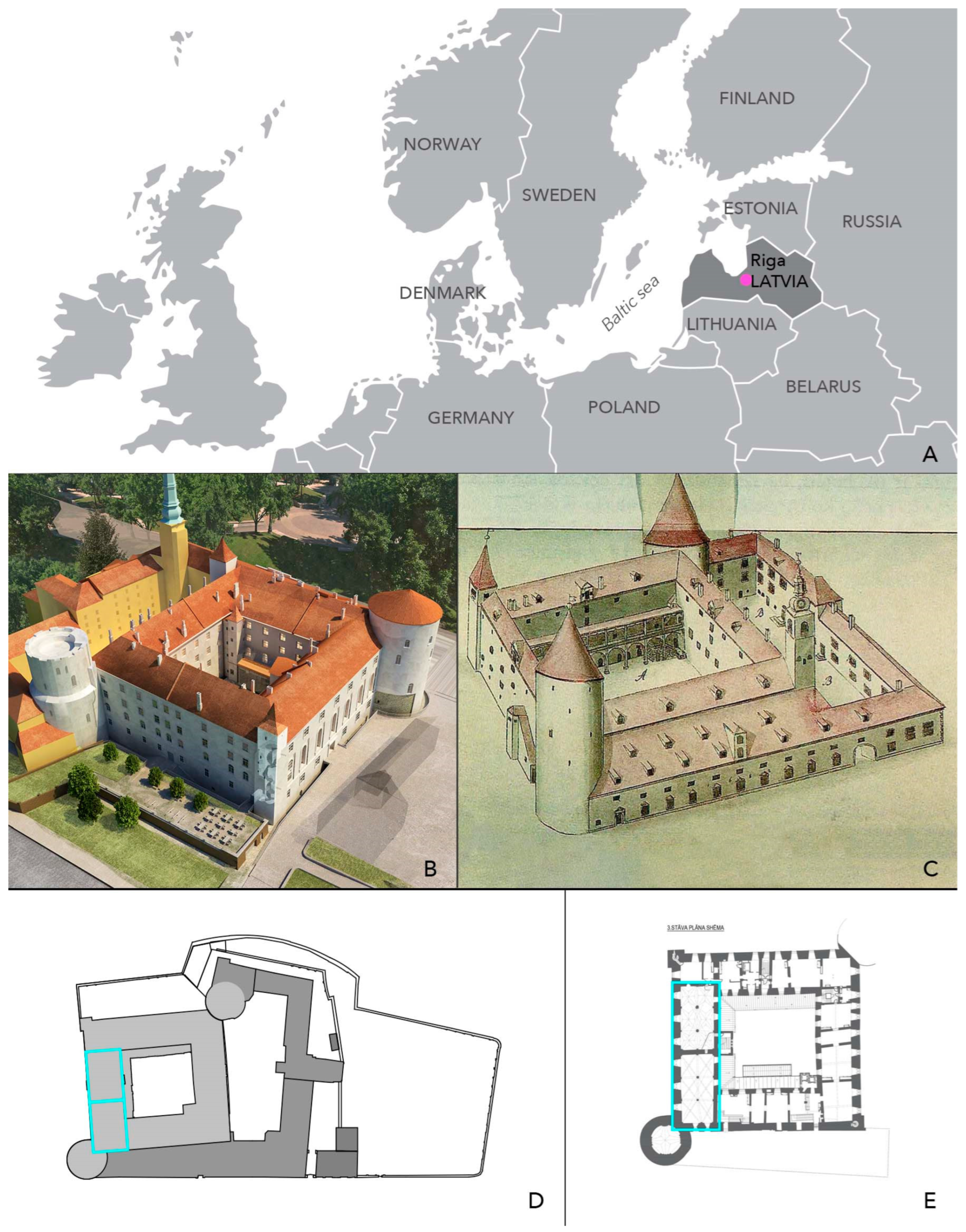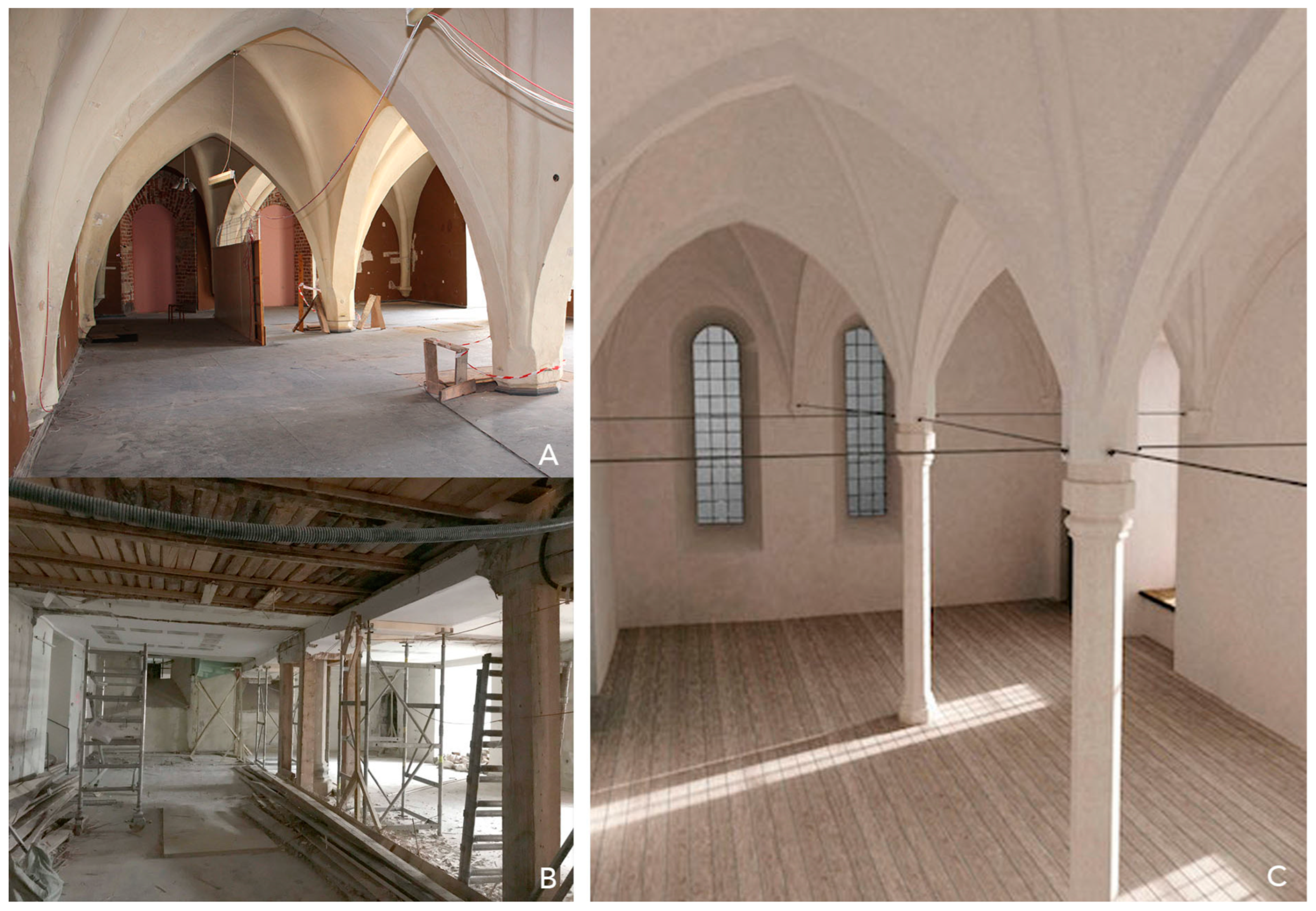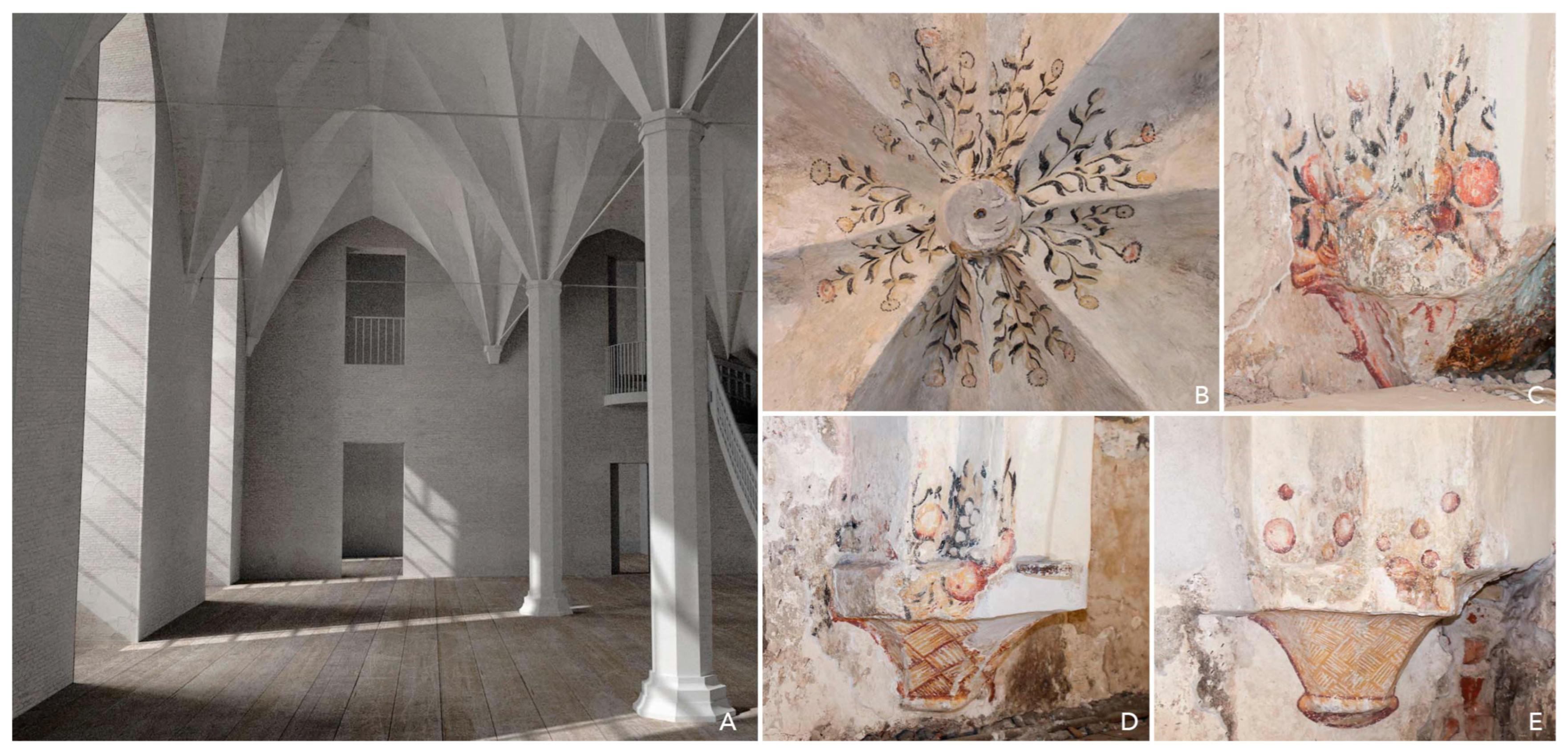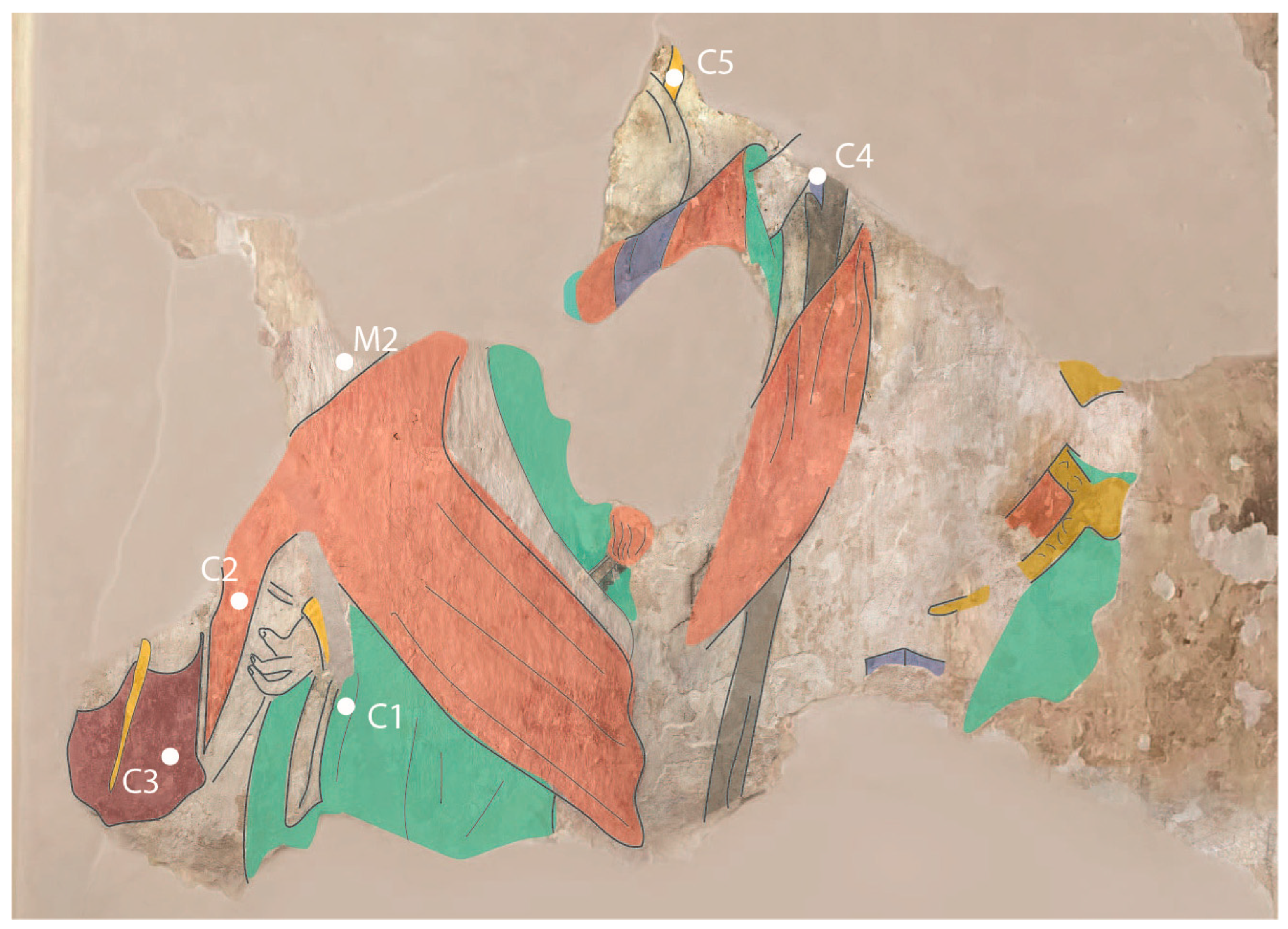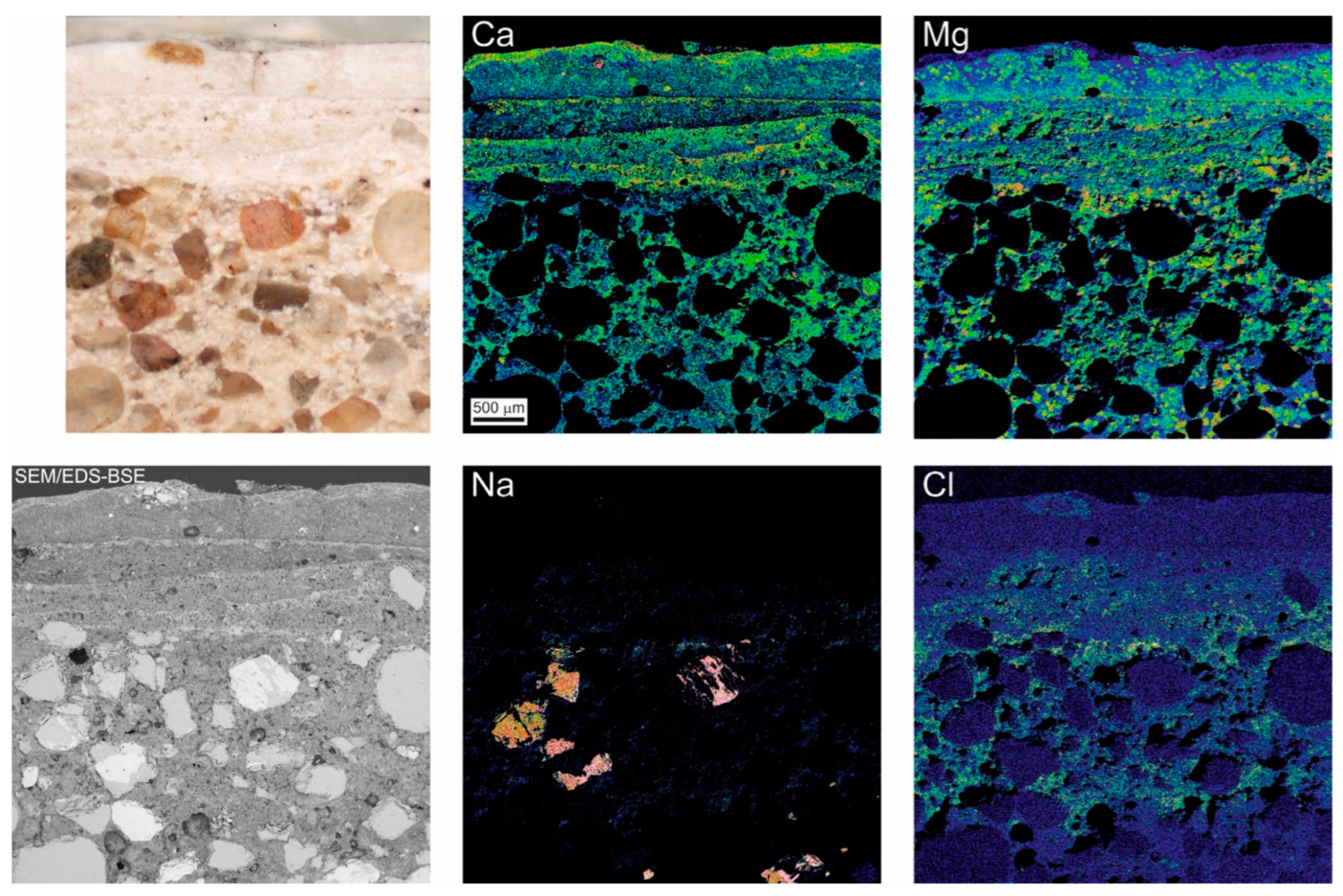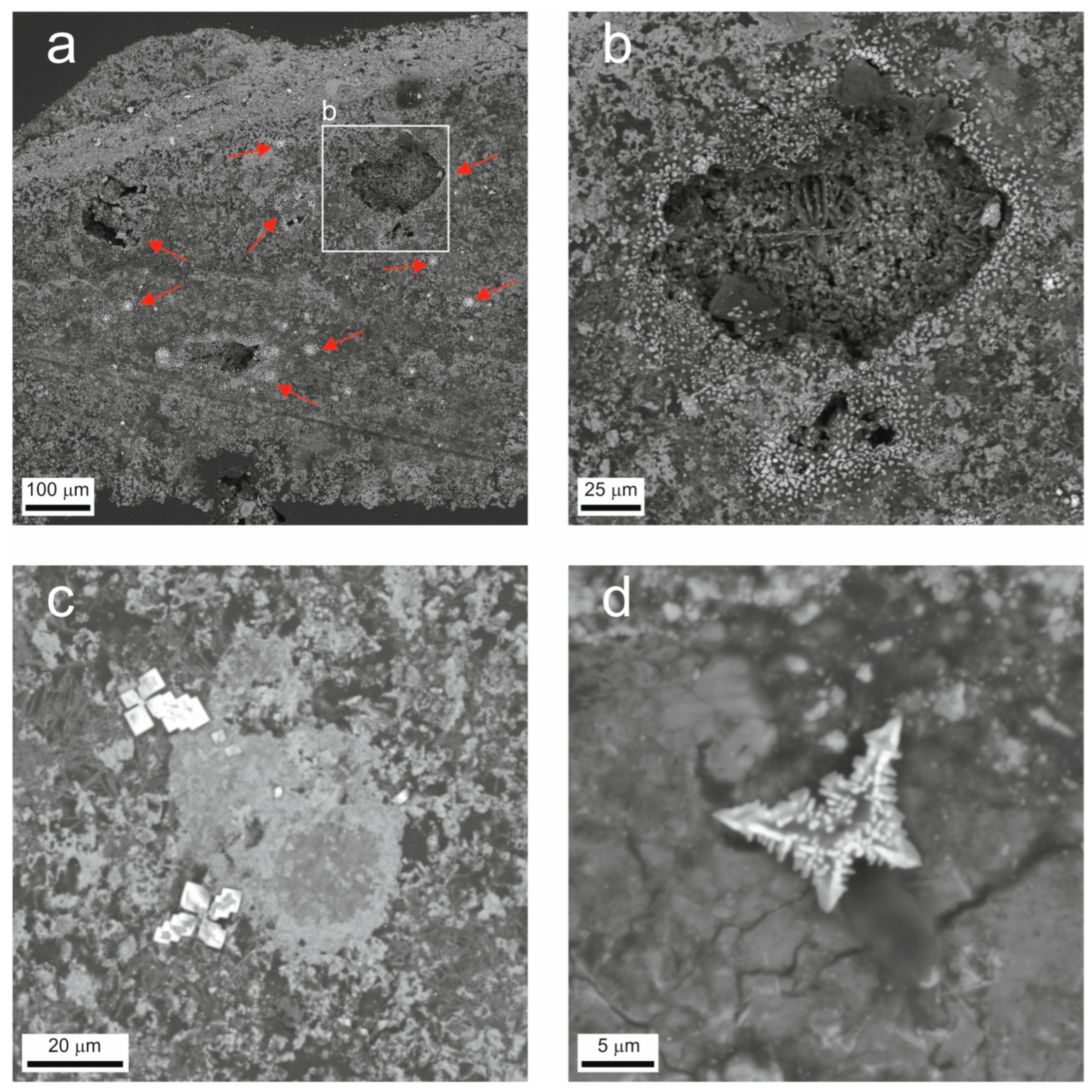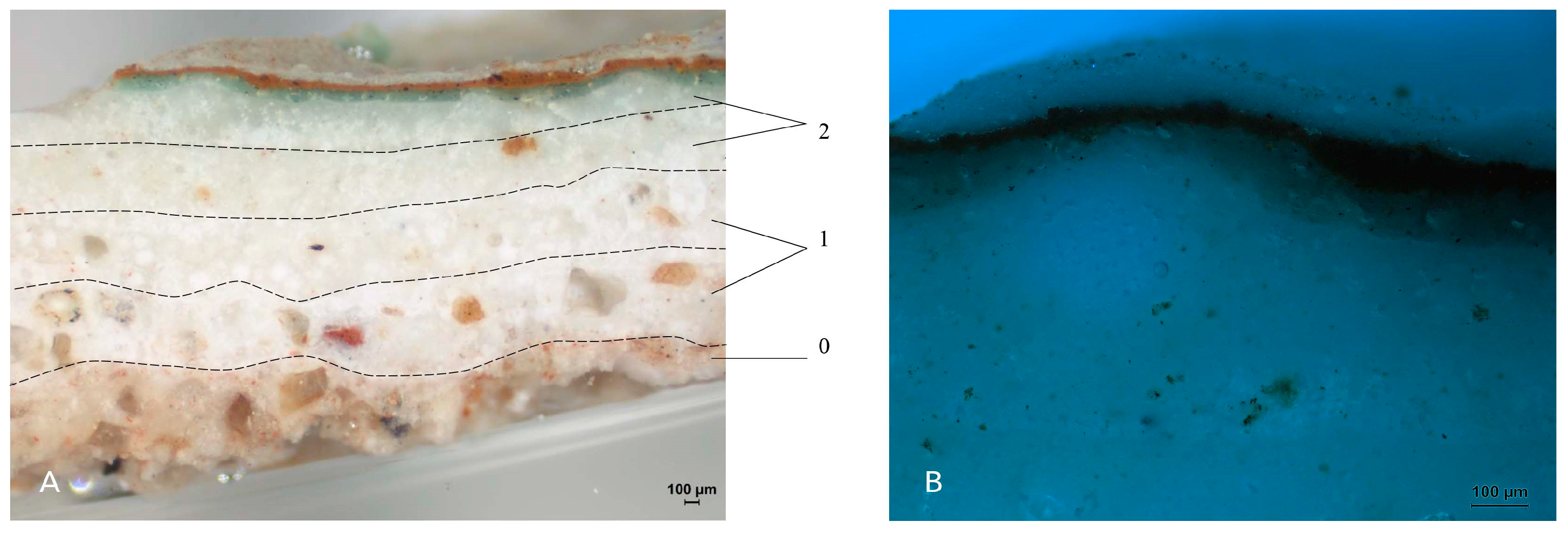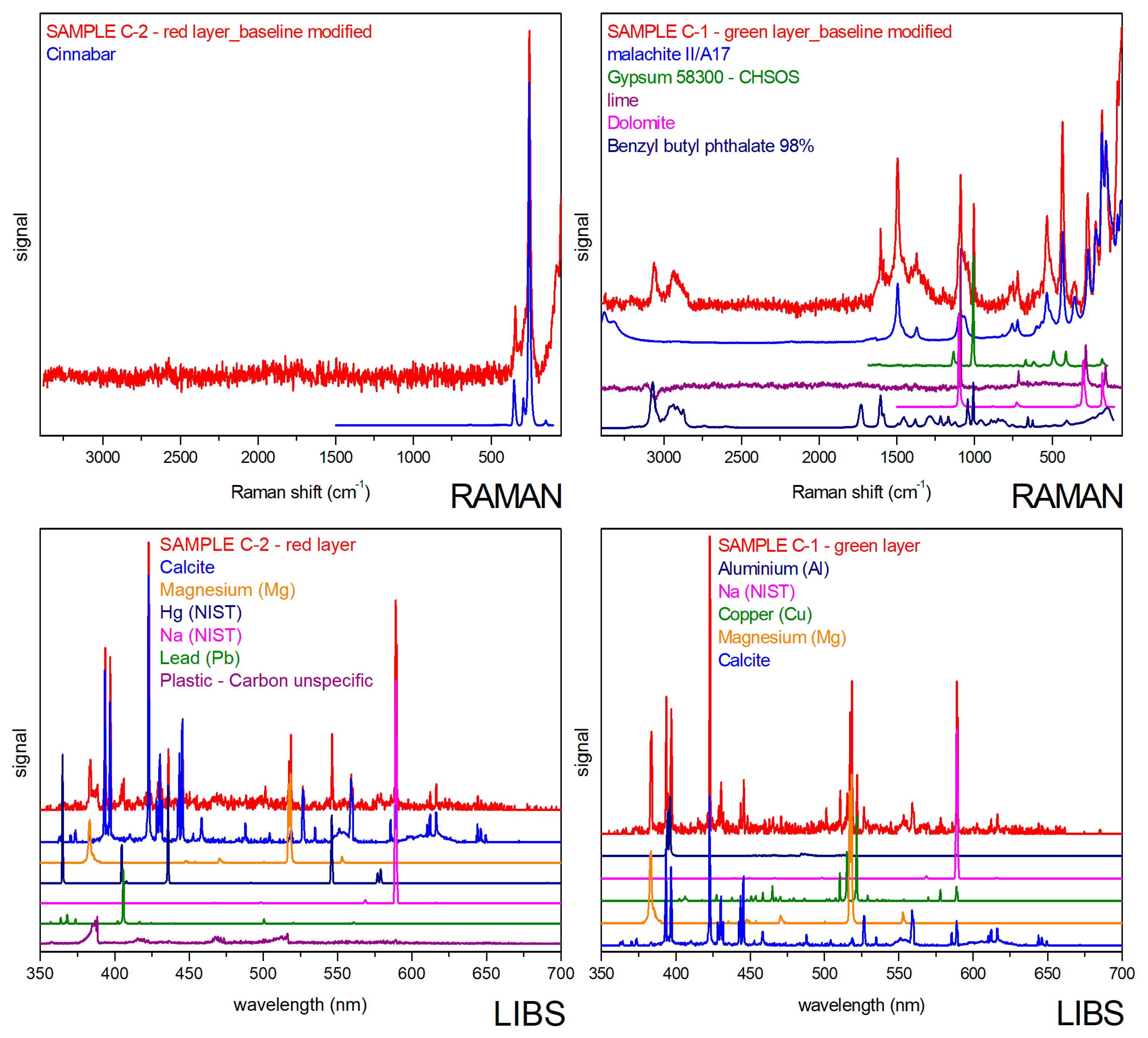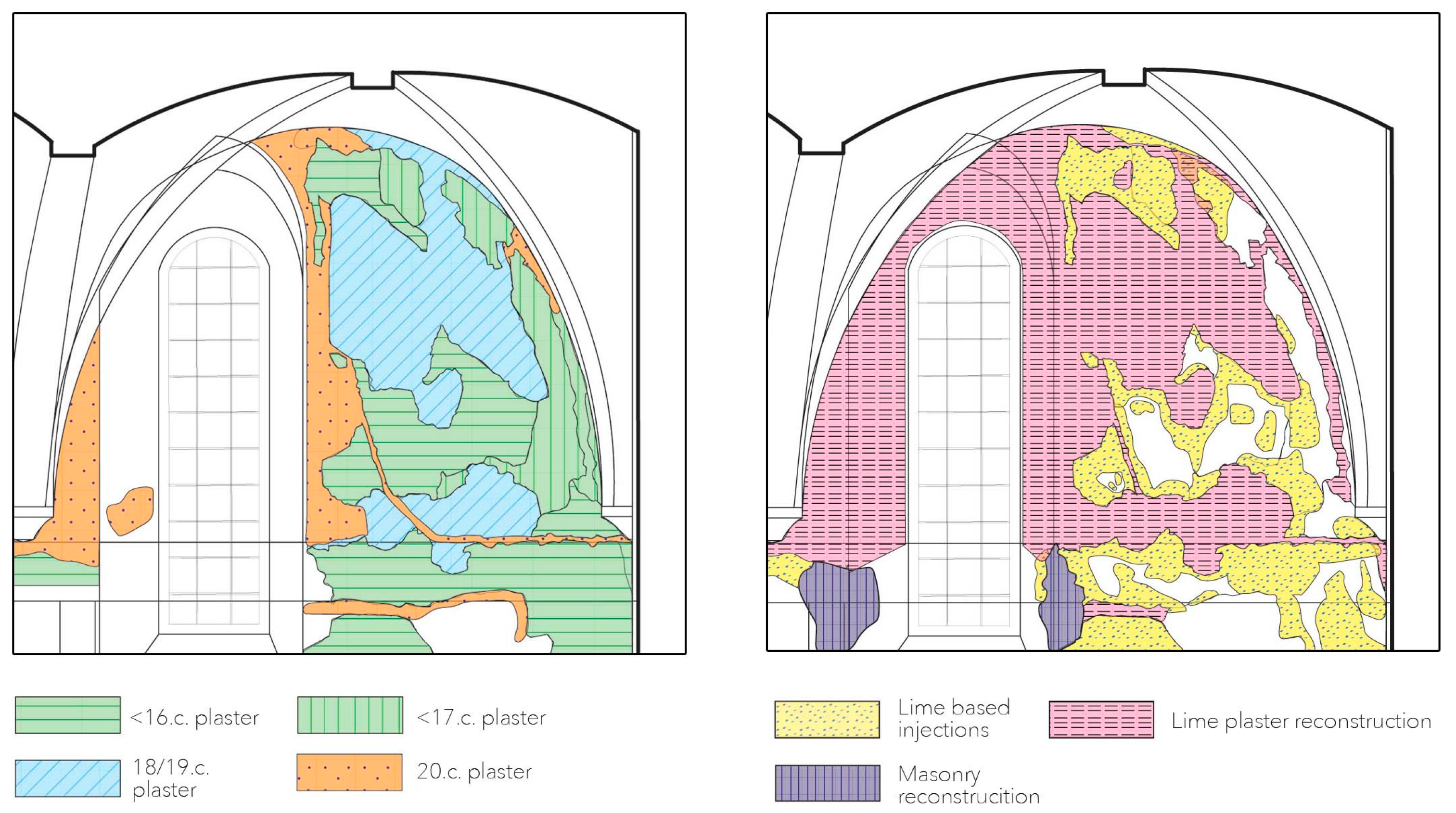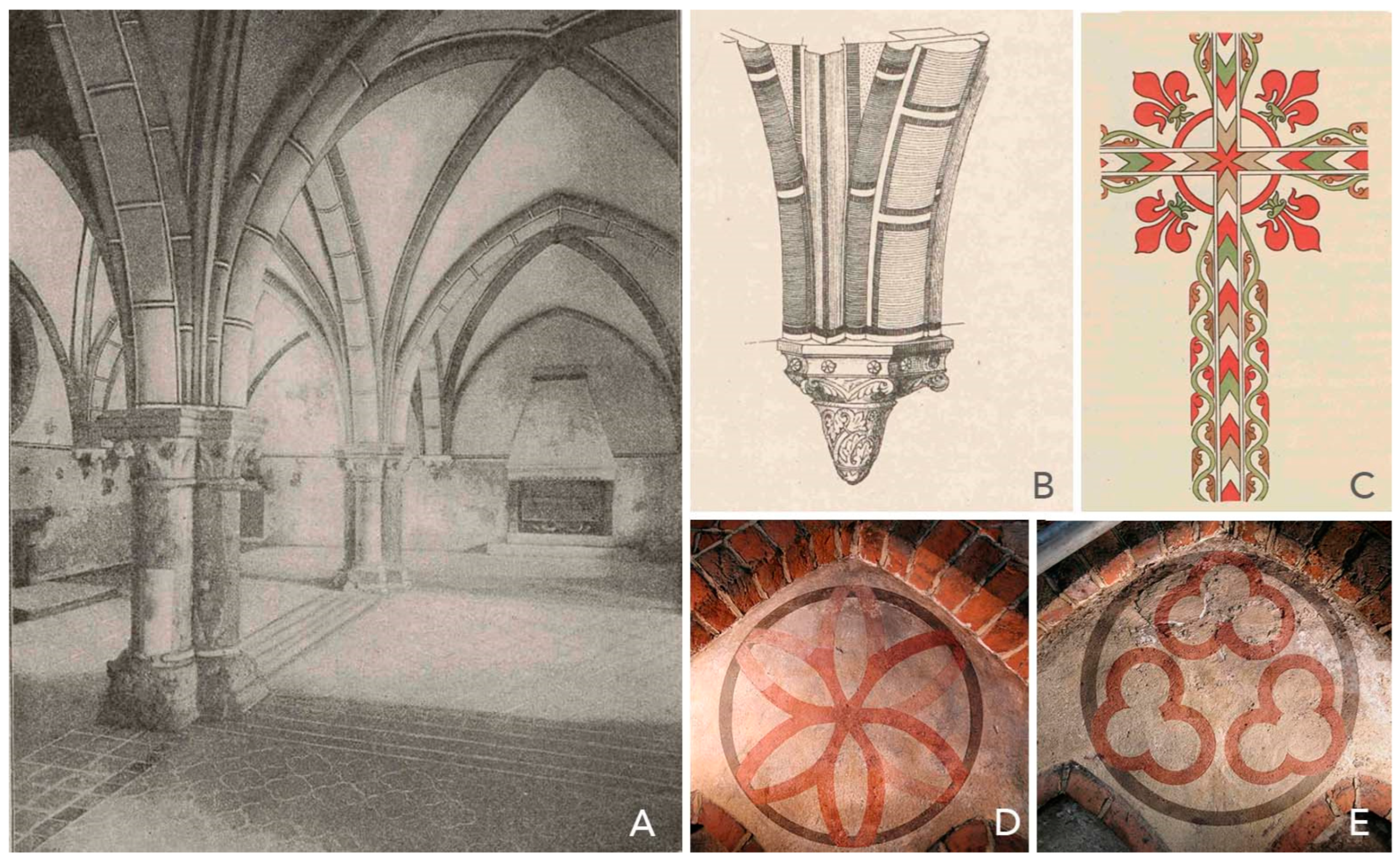1. Introduction
The significance of the Castle of Riga stretches beyond the borders of Latvia, as the castle is one of the best preserved of the Teutonic Order’s castles. Its architectural form and many details have survived since the 16th century CE. One of the most important recent discoveries is a medieval fresco on the castle’s chapel wall, together with Renaissance wall paintings found on the refectory vaulting.
For the frescoes, extensive pre-restoration research and restoration works were conducted. The main questions addressed in this article are related to research on the materials and various craftsmen’s techniques used to create the art piece in the chapel. Research on the painting materials helped to clarify the medieval fresco’s details regarding pigments, paints, and painting technology. Due to the overall absence of comparable art pieces in the Baltic region, its iconography and general significance are also discussed in a wider context (specifically with artworks in other locations related to the Teutonic Order).
2. Site and Project Description
2.1. History
Since its beginnings in the 13th century CE, and up until the 19th century CE, Riga Castle (
Figure 1) was always a symbol of power for its owners—mainly as a fortification building. Up until the mid-16th century CE, it was the residence for the Livonian Order. After that, as a material symbol of power, the castle was used as the residence of the Polish King Stephen Báthory, Governor General of the Polish–Lithuanian Commonwealth, Governor General of Sweden, and Governor General of Russia. In 1922, it was adapted to become the residence of the President of the Latvian State.
As seen today, medieval Riga Castle is a square-shaped building with four parts, an inner yard, and towers in its corners. Later—starting from the 17th century CE—the castella received permanent addition to its northern and eastern sides—a front castle and an extension building. The medieval building had two habitable floors and weaponry storage in the attic. At that time, the basement was only used as storage, and the first floor served different household needs, such as workshops, food storage, etc. The main premises (the Order’s dining room, refectory, chapel, capitulum hall, living rooms, and other premises) were located on the second floor.
Riga Castle was the third building for the Order in the city—the first one was located in the centre of the newly founded city, and the second one was built just at the riverbank—directly at the harbour in the exact location as today’s (built around 1340). However, it was demolished during the military conflict between the Livonian Order and Riga city-state (1481–1484). After the destruction, the third castle was partially rebuilt. When both sides agreed on a peace contract (1491), it was concluded that the castle, which Riga citizens needed to restore, should have “the same church and refectory as it had before” [
3,
4], including the dimensions of the rooms and vaulting as they had before. The medieval castle that we see today was built starting from the end of the 15th century CE until 1515 [
3]. The chapel and knights’ dining hall (refectory) have remained until today, but they have had several structural changes over time (
Figure 2).
The chapel’s location and general look are identified in the 1590 description [
7], which is sufficiently detailed (and considered the most meaningful document about the Livonian Order castle’s architecture [
8]). The room is also depicted in house plans from the 18th century CE, pictured with six groin vaults and two columns. The refectory is seen as a large, representative hall with eight rib vaults and three columns. Considering the chapel, galleries next to the chapel and a “church with its all accessories” were mentioned in the 1590 description along with “two great windows on the eastern wall and three on the south side”. There was no information on the appearance of the altar or of any paintings on the walls. In the revision of the refectory, there is written material about stairs to the balcony of the chapel from the first two bays on the eastern side of the refectory, and that four bays on the western side had been the “king’s dining hall”; as such, the room could be split into two parts, with the first four bays as the knights’ dining hall and the other four bays as the king’s dining hall.
The refectory experienced significant damage, most probably in 1656 when Russian forces surrounded and fired upon the city. Damage also likely occurred in the tower next to the refectory (Pipera Tower), which could be why the last two bays on the western side were reconstructed by removing the two vaults and constructing a supporting wall [
8]. At this time, the refectory was likely made into a six-bay hall instead of the eight-bay hall. Now, we see the division of the original single-floor refectory into two separate floors; however, the timing of that division remains unsolved. This reconstruction certainly was carried out before the beginning of the 18th century CE. Since then, the refectory was divided into smaller rooms that were used as separate apartments with kitchens. Later, in 1870, the first floor of the refectory was used as the office of the Governor General of Russia. An upper floor served as an apartment and premises for the guards of Riga Castle.
The chapel (
Figure 3) was a religious venue until the 19th century CE. After the Catholic period (13th–16th century CE), the chapel was used for Protestant services, and all the paintings found there were whitewashed. Then, under the reign of the Polish–Lithuanian Commonwealth (from 1582 to 1621), a policy of re-Catholicization appeared. After 1710, the castle was used as the Governor General’s residence, and it was adapted for Orthodox ceremonies. In 1714, the chapel received a new altar [
3]. A new iconostasis was installed in 1757 next to the first St. Mary’s altar table. In 1747, the chapel received another entrance directly from the street by reconstructing one of the windows on the southern wall, which was redone in 1771 [
6]. Until the mid-19th century CE, the place was renovated several times, with changes to the interior, windows, and entrances; however, in 1870, the Governor General of Russia (knaz Piotr Baration) decided that these premises were no longer suitable for their religious purposes. The room was divided into two floors in two years, just like the refectory next to it. The new rooms served the Governor General’s purposes as archives.
After the founding of the new country of Latvia in 1918, Riga Castle was gradually adapted to the new requirements. Part of the castle became a residence for the president of Latvia, while the other part, the old castella, was used for different institutions, including the National History Museum. Ever since then, the chapel and the refectory have been used for the museum.
2.2. Restoration Project
The research and restoration described in this case study is a part of the larger castle reconstruction project, where the castle’s building is being adjusted to the new needs of the National History Museum of Latvia. The reconstruction project started in the year 2020 and is expected to be finished by 2024. For almost 100 years, Riga Castle has been a museum. After reconstruction, it will be a display for visitors—about a location with a great history, itself being an exhibition of Latvia’s national heritage.
The main task of the restoration today is to bring back the look of the old premises of the chapel as they were in medieval times, as well as in the Renaissance for the refectory; therefore, removing the extra flooring and gaining back the actual original height of the rooms (about 9 m). Reconstruction of the interiors to be as close as possible to their originals is another challenging task.
For the current reconstruction project, active research on the castle has been conducted since 2013. The history of the building has been investigated by archaeologists [
9,
10,
11], architects and researchers [
8,
12,
13,
14], and with, historical research, both visual and written artefacts have already been studied for several centuries [
2,
3,
5,
6,
15]. The Castle has experienced a very complex history; and only a few artefacts have survived since its beginnings. The medieval and Renaissance paintings found very recently (in 2015 and 2017 during research on the interiors) represent one of the most outstanding discoveries. The poor state of the paintings in both premises (being too fragile) did not allow the full opening of the paintings then. At that time, it was known that medieval painting fragments depicted a figure on the eastern wall of the chapel [
14] while, in the other room—the refectory (
Figure 4)—a fragment of a very rich and colourful painting of a flower and fruit basket on a vault console was found [
12,
13]. This was a very promising and challenging start to the restoration.
3. Materials Research
After discovering the fresco fragments in 2017, samples representing the colours, plasters, and mortars were taken for further research. Concerning the medieval remains, the painting in the chapel is the only remaining and vivid evidence of colouring so far. The following samples represent the plaster (M2) and the principal colours in the studied fresco, namely light green (C-1), bright red (C-2), dark red (C-3), blue (C4), and yellow (C-5) (
Figure 5 and
Table 1).
Laboratory investigation of the colour layers with plaster was primarily conducted through reflected light optical microscopy using polished cross-sections of the specimens. The polished cross-sections were obtained by casting small fragments of colour in a polyester resin and polishing it after hardening. The polished cross-sections were studied in a Leica DMLP microscope in visible and ultraviolet-reflected light modes.
Scanning electron microscopy with energy dispersive spectrometry (SEM/EDS) supplemented the optical microscopy to reach better identification of the chemical composition in the individual layers and its phases in colour samples and stucco/mortar layers. In addition to the colour samples, where stucco layers were seen, a plaster sample was taken next to the coloured part of the painting (sample M2). In SEM/EDS analyses, part of the study was executed by backscatter electron imaging (BSE) and informative point chemical microanalyses using a Tescan Vega instrument equipped with a X-Mag 50 energy dispersive detector from Oxford Instruments. Compositional elemental maps were obtained with an accelerating voltage of 15 kV, probe current 6 nA, and resolution of 1024 × 1024 points to obtain information on the distribution of specific elements in the selectively analysed parts of the polished cross-sections.
An analytical study of some pigments was followed by Raman spectroscopy using the same specimens as were studied by optical microscopy. For the Raman spectra, a dispersive Nicolet DXR2 Raman microscope (Thermo Fisher Scientific Inc., Waltham, MA, USA) with a laser wavelength of 532 nm, full range grating, CCD detector, and magnification of 500× (the objective 50×) was used. Raman spectra were obtained in the range of 3380–50 cm−1 at a spectral resolution of about 5 cm−1 with a 25 μm pinhole aperture, varying laser power (from 1 to 10 mW), and an exposure time of 1–15 s, with 20–1000 scans using Omnic software (Thermo Fisher Scientific Inc., Waltham, MA, USA). The obtained spectra were interpreted using standard spectra from the various available spectral databases.
In the case of LIBS, a metallographic Leica DM6 microscope combined with a LIBS spectrometer was employed (using a mono-pulse nitrogen gas laser operating under the following conditions: wavelength of 337.1 nm, average pulse energy up to 150 μJ, frequency of 30 Hz, and pulse duration of 3 ns, measured spot diameter of 15 μm, detection range of 360–700 nm, CCD detector, 0.6 nm resolution, and objective NUV 20×). The LIBS spectra were acquired by using LAS X software (by Leica - Leica Application Suite X for Industry) and analysed by using SpectralTools software (Leica microsystems CMS GmbH; Wetzlar, Germany). The final editing of the spectra was carried out with Omnic software (Thermo Fisher Scientific Ind., Waltham, MA, USA).
4. Results of Sample Analyses
4.1. Mortars
Based on the analytical results, it can be concluded that the mortar and stucco layers under the medieval painting contain a dolomitic lime binder made of materials typical for the region [
16]. Regarding the aggregate, the natural river sand is composed predominantly of quartz grains (65–75 vol. %) and less abundant lithoclasts (15–20 vol. %) and/or K-feldspar clasts (5–10 vol. %). Sand grains are mostly well-rounded, but quite heterogeneous in their grain size distribution (mean grain size is about 210 μm, upper 10% is over 750 μm). Observed characteristics of sand correspond to previously studied mortars from Riga Castle [
17]. In the case of binder, its phase composition (a mixture of calcite, two huntite-like phases, namely Ca-rich Mg-carbonate and Mg-rich Ca-carbonate, and hydromagnesite) resulted from the use of dolomitic aerial lime, representing another characteristic material for the whole region [
16]. The binder/aggregate ratio was found to be close to 1:2.2 (31 vol. % of a binder, and 69 vol. % of an aggregate) as determined by petrographic image analysis of SEM/EDS images using the same analytical approach as in our previous study of mortars from the Riga Castle [
17].
The SEM/EDS elemental mapping also revealed the presence of water-soluble salts (sodium chloride and potassium chloride) in the mortar and some stucco layers (
Figure 6 and
Figure 7).
4.2. Decorated Plasters
The above-mentioned analytical protocol also allowed for detailed determinations of the compositions of the colour layers studied and the stratigraphy of the wall painting. It consists of a core dolomitic plaster, two layers of dolomitic stucco, and two coats of dolomitic lime paint. In the last layer, traces of a drawing underneath with charcoal were discerned (
Figure 8).
Then, on fresh lime paint, there is a layer consisting only of pigments applied onto the fresh plaster. Some samples also showed a second layer where the pigment was mixed with some protein. Primarily, a true fresco technique was used [
18] and, in some areas, protein secco was applied—so, in general it can be called a combined fresco technique.
The medieval chapel’s painting had five colours—green, red, dark red, blue, and yellow. Dark red and yellow were detected as iron oxide pigments. Blue was an azurite pigment. Red was detected as cinnabar, and green as malachite (
Figure 9 and
Figure 10).
5. Restoration
The state of the fresco fragments had been influenced by the destructive conditions of the building as well as the aggressive repairs performed in the past. The painting was surrounded by younger plasters (as well as cement-based ones). Because of these destructive repairs and other factors, the original plaster had reached a very bad state—it was fully cracked, commonly detached from the wall, and deteriorated. The condition of the fresco was so fragile that it made the uncovering of it and its conservation very time-consuming and complicated.
After investigating the wall openings made in 2018, the interior appeared promising for the medieval painting to remain over a more extensive area than could be seen prior to the excavation. However, after the opening-up of the plaster, it revealed that only a few fragments of the essential parts of the original painting remained: the heads, shoulders, and the areas above the figures were missing, and mostly showing the much denser 19th century CE mortars. The original fresco was left so fragmented that even those pieces remaining were significantly damaged. One of the causes of destruction were electrical wires that were installed in the 1960s, which removed large areas of the remaining fresco (
Figure 11).
The surface of the painting was also covered with dirt, salt, and salt crusts. All of the area has a lime layer above the painting. This layer had protected the colourings, but it is also strongly attached to the layer below, and hides the actual brightness of the original medieval painting. The coating is either from a conservation treatment, or a trace from a plaster applied on top afterwards. So far, it has been decided not to remove the lime crust from the surface by some mechanical or chemical treatment to avoid losing the fragile medieval polychrome layer below.
The surface cleaning was carried out by dry cleaning methods—brushes, sponges, and a scalpel. As the plaster was detached from the wall in many places, cleaning the mortar particles filling the empty areas behind the fresco was often necessary. Next, the cleaning was carried out using different hand instruments—small spatulas, pincettes, and manual air blowers. For consolidation, first, the fragile original plaster was strengthened with a nano-lime consolidant (CaLoSil E25), gradually increasing the concentration from a 5% solution to 12.5% solution. Then the empty voids were filled with lime-based injections (Ledan, Vapo Inject) using various kinds, depending on what was needed. The open area behind the plaster was often 5–15 mm wide, but it was also common to even fill very fine detachments on the surface of the fresco, where the painting was only detached by 1–2 mm.
Calosil E25 3–5% solution in ethanol was used for the colouring surface. Nanolimes, in general, present the same high compatibility and durability of the traditional lime–water technique; however, they have superior properties in terms of higher consolidation, penetration, and reactivity, as well as fewer side effects [
19]. Lime-based injections for structural strengthening have been widely used for several decades [
20,
21,
22].
After conservation, all of the 18th–20th century CE plasters were replaced by lime plaster and painted a neutral lime colour (
Figure 12,
Figure 13 and
Figure 14). The restoration works are still in progress, and the mode of the fresco’s presentation in the chapel is being discussed. There are trials for surface cleaning of the white lime haze being carried out, and the project work group is discussing possible solutions for a better exhibition of the remaining fresco fragments.
6. Local Characteristics of Medieval Paintings
The land on Europe’s north-eastern shore of the Baltic Sea, known as Livonia (modern Estonia and Latvia), was one of the last pagan regions, where the Christian mission started in the final two decades of the 12th century CE. There was a long era of warfare between the European Christian and indigenous cultures that demonstrated the superiority of the conqueror’s organization and technology. By the second half of the 13th century CE, they had secured their domination over Livonia despite being vastly outnumbered by their indigenous opponents [
23]. Because of the fact that Christianity started in this region later than in other countries of Europe, it has long been considered that the decorative artworks in the interior of religious buildings would have been much simpler. However, it needs to be taken into consideration that for several centuries this territory, including during medieval times, had been an important part of Europe and as well as a meaningful trade centre. Unfortunately, because of its location on the political map, the territory has often been a combat zone for many military conflicts of neighbouring countries, and has also suffered battles between different interest groups from inside the country. As a result, most of the medieval architectural heritage was destroyed shortly after it could have been created, such as during the Livonian War (1558–1583), when the Russians invaded Old Livonia, or in the other military conflicts that followed in the current territories of Latvia and Estonia.
Historical resources and recent findings of medieval art from the time of Livonia relate to only a few remaining wall decorations, such as the colourings on vaults (
Figure 15A–C) or facades (
Figure 15D,E). As for paintings depicting humans, there was a figure painting in St. Catherine Church (
Figure 16A), as well as reports of figurative paintings in other cities in Livonia, such as bishops’ portraits in Rauna Castle [
24]. Unfortunately, all of these mentioned paintings and drawings are either already lost or remain in a very fragmentary form.
However, a significant fresco has been preserved, and it is worth describing it in greater detail. Art historian Elita Grosmane has outlined the known historical and restoration research [
26], but the main facts about this decoration are as follows. It is a detailed figurative painting showing the Madonna’s coronation by Christ (
Figure 16B), and the family tree of Christ with medallions and two figures of prophets (
Figure 16C). The painting dates back to the 14th century (by Grosmane, years 1360–80 CE). The fresco was discovered in 1891 (by the architect Mohrmann). At that time, it was partly reconstructed, and in 2009–2010 it was restored under the supervision of the Czech restorer Miloš Gavenda. Already by 1891, the painting technique was described as typical of medieval fresco techniques in Europe—first, a charcoal drawing on a fresh lime layer was made, next the main colours were applied, and afterwards, on an already dry surface, the next two or three layers with tempera colour followed. The recipe for the tempera colour is claimed to be from 12th century CE monks (Theophilus Rugerus’s written notes) where a lime-based colour is mixed with egg yolk or egg just before applying. For the final layers, the colour can again be mixed with egg yolk or dissolved resin [
27].
This painting of the Coronation of St. Mary in the Dome Cathedral in Riga has been studied by several independent researchers since 1891 [
26,
27,
28], and even though there are different opinions as to who the artist was, there is one common conclusion—at the time that this painting was produced, the artist came to Riga to work from some other part of medieval Europe. It is defined by the professional quality of the painting and the iconographic details that are up-to-date with a typical 14th century CE depiction of the current theme. The assumption that various non-Livionian art masters produced local artworks has also been claimed in the case of stone carvings. Riga Dome Cathedral is very rich in carved medieval architectural details—consoles, capitals, columns, and portals—all very beautifully showing colourful depictions of medieval stylistics. These researchers have noticed different characteristics among the carvings, and explain these with their origins possibly being from different craftsmen [
5,
29]. Furthermore, that kind of craftsmanship can only be found in buildings of great importance, such as in some churches and castles.
7. An Attempt at Iconographic Analysis
There have been several assumptions made about the characters depicted in the fresco of the Riga Castle chapel. However, it also needs to be considered how fragmented the fresco is, and how few characteristic drawing elements have remained.
To make some possible guesses, one needs to have a broad overview of how late medieval Riga looked and what had happened in that part of Livonia in the period when the painting could have been carried out. These territories, newly conquered by the Christian military order (the Livonian Order), were also called “Terra Mariana”, in honour of the Virgin Mary, who was introduced and then widespread all around the Baltic Sea. During the medieval Catholic centuries, every church and chapel had an altar devoted to the Virgin. On the doorways and gateways of castles of the Teutonic Order, as well as of the bishops, the statues and frescoes of the Virgin reminded the visitors about the patroness of “Terra Mariana”. The iconography of the Virgin Mary in Prussia and Livonia had a political character, and the images of the Virgin were perceived and as equally adored as images of Christ. Because of the increased role of the Virgin, the variety of iconographic stories were interpreted as the adoration of the Virgin [
30], which created an entire cycle of “Mariology” where such compositions as Annunciation, Virgin with Child, Pieta, the Coronation of Mary, the Death of Mary, Mary the Protector (in German, Schutzmantelmadonna), as well as other motifs in the form of frescoes, sculptures, or plastic reliefs filled the walls, altars, portals, and doorways. Parallel to this cycle of “Mariology”, the knights of the Teutonic Order worshipped such apostles as St. George, St. John the Baptist, and St. Lawrence.
The Hanse Union influenced the local adoration of saints important in other countries, such as St. John the Baptist, St. Peter, and St. John the Evangelist, or saints related to shipping and logistics, such as St. Jacobus, St. Nicolaus, St. Christopher, and St. Andrew. The iconography of these may be found in the names of churches and monasteries, altars, frescoes, and statues. There is a magnificent fresco of St. Christopher in the Church of St. Nicolaus in Wismar. It is a reminder that the church, built at the end of the 14th and 15th centuries CE, served sailors and fishermen. Another example is from the Hanseatic city of Thorn (today Torun in Poland), where there are frescoes of St. Christopher, St. Stephan, St. Andrew, St. John the Baptist, St. Lawrence, and the Archangel—the protector of pillars in the Church of St. Mary [
31] (p. 111) (
Figure 17B–D).
Damage and loss to the plasterwork on the eastern wall of the Riga Castle’s chapel only allowed us to possibly approach iconographic versions of the partially preserved figures. As this article suggests, any interpretation of the fragments of these lost figures can only be considered as hypotheses.
Because of the Teutonic Order’s religious orientation based on a cult of the Virgin, we can assume that the chapel would have had frescoes of the Virgin and Christ. One of the remaining examples of the Order’s depiction of this theme is the fresco with the Coronation of the Virgin Mary from the refectory in the Warmian Bishop Castle in Heilsberg (today Lidzbark Warminski in Poland) dated 1380 [
31] (p. 37) (
Figure 17A). The remnants of Riga Castle’s frescoes only allow us to see the lower parts of the bodies, once painted with silhouettes of draperies and the presumed accessory details. However, if it was to depict St. Mary and Christ, it could be interpreted as Christ the Saviour, or Christ on one side, and the Virgin on the other. Dating of the Riga frescoes is unclear, as is much of the castle’s history. Relating to recent studies, the eastern wall of the chapel is dated to the early 16th century CE, although from written artefacts, it is not clear how much of the old castle was integrated into the new one. The authors of this article consider that the dating could also be earlier. If so, the fresco could also date from the late 14th century CE or early 15th century CE, as in the mentioned related paintings in other Teutonic castles [
31] or in the case of Riga Dome Cathedral [
26].
Nevertheless, the questions of what was intended to be seen on the altar wall of the chapel and the dating of this fresco remain open. Furthermore, as described previously, historic events in the Livonian region were not merciful, and only a few art pieces have remained in this region from medieval times. As such, even these minimal remnants of the fresco are relevant materials for further medieval art studies in the Baltic Sea region.
8. Conclusions
The discovery, unveiling, and conservation of these fresco fragments in the chapel of Riga Castle was a challenging task in this outstanding monument of medieval culture. Because there are, generally, very few preserved fresco paintings from Livonia, art historians and restorers pay great attention to this original piece of interior decoration.
In this case, the restoration process demonstrated the need for using combined laboratory research methods to show the fresco painting technique and the materials employed. The analytical work revealed the precise usage of some materials—particularly pigments and techniques—that can be found in only a few specific and important buildings, such as in cathedrals and some churches. This study describes why such paintings can be assumed to have been produced by travelling artists from other medieval European cities, and, thus, were not produced by any indigenous craftsman.
The laboratory investigations and analysis proved that the painting system was common to other European countries—the layers of stucco and several layers of lime paint, followed by a direct charcoal drawing underneath, then with a pigment–water paint. This can be called the “classical” fresco system of the medieval period. Thus, not only do the materials used(non-local pigments) and the drawing itself, but also the painting technique, demonstrate that the fresco was produced by an experienced master; this was also concluded for another medieval fresco in Riga, namely the Coronation of St. Mary in Heaven in the Riga Dome church.
As to conclusions about the meaning of the iconography, the cult of the Virgin was of great importance in medieval Riga. Thus, it would be logical to attribute the remaining fragments of figures to St. Mary and Christ on the wall of the chapel. As such, in this case, assigning the figures to some other saints is less possible. However, the question remains open to further research.
The very difficult restoration works on the fragile remains of the painted surfaces led, however, to the successful renewal of the historical appearance of the chapel’s interior. The removal of the extra flooring could be carried out securely and without any loss to the main drawing’s details. Together, the work has resulted in a rather accurate restoration of the historic interior.
The restoration work is still in progress, so the full presentation of all the fresco’s fragments is yet to be decided. For the proper understanding of medieval heritage, similar laboratory investigations should also be carried out on other important buildings of medieval architecture in the Latvian and Estonian territories. This would increase our knowledge and clarify questions about the characteristics of similar painted surfaces as to their properties, techniques, and possible similarities.
